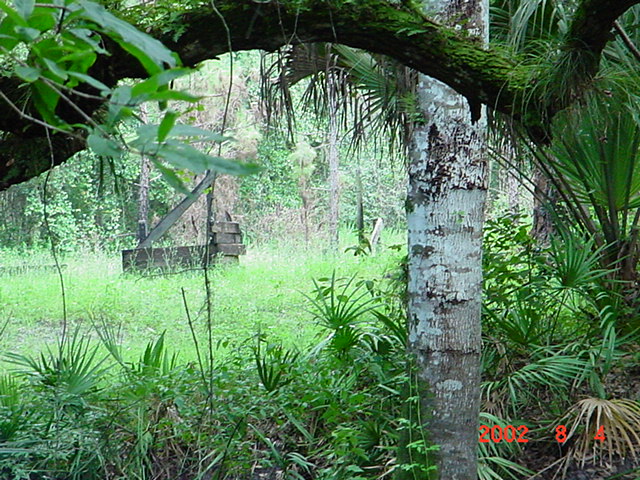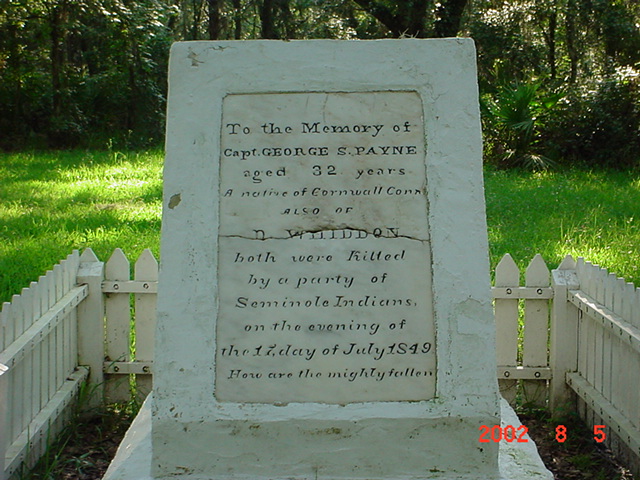
1849 Indian attack
Affidavits Of July 1849 Indian
Attack
Transcribed by: Spessard Stone
Used with permission
These affidavits by the McCulloughs were published in The
Herald-Advocate (Wauchula, Fla.) of July 9, 1992 as "Affidavit Recounts
1849 Indian Attack." In the newspaper article, the affidavits were
re-paragraphed for easier reading, but here appear as in the original in
Kennedy & Darling to the Hon. Thomas Ewing, 31st Congress, 1st Session
[Senate], No. 49, May 21, 1850. Editor's note: The Kennedy-Darling store
was located within today's Paynes Creek State Historic Site, southeast
of Bowling Green, Florida.
To the Hon. Thomas Ewing,
Secretary
of the Secretary
Seminole or Florida Indians, A to I, inclusive from
Department of the Interior.
(A.)
Tampa, Florida,
August
11, 1849.
Sir: Herewith enclosed we hand you the affidavits of
William McCullough, Nancy his wife, and Louis Lanier, citizens of this
county. Be pleased to consider and file the samewith our letter to you
on the 25th July last.
With due respect, we are
Your most
obedient servants
KENNEDY & DARLING.
Hon T. Ewing,
Secretary Department of the Interior,
Washington City, D. C.
State of Florida,
County of Hillsborough
(L. S.)
Personally
appeared before me, Judge of Probate, in and for the county and state
aforesaid, William McCullough, who having been duly sworn according to
law, says he was hired by Messrs. Kennedy and Darling on the 3d day of
July, 1849, and arrived at their Indian store on Peas creek on the that
day and remained there until it was burned by the Indians on the 17th or
18th July, 1849.
On the 17th July about noon Echo Emathlo Chapko
and three squaws came to the store, bringing a large quantity of water
melons of which Captain Payne purchased some 9 or 12, at the same time
telling the Indians that he could have purchased them all but he did not
think the melons would sell in New York to advantage. The Indians also
brought venison, sweet potatoes, skins and beeswax, all of which was
purchased by Captain Payne. Echo Emathla Chopka stated that he would
return a pony he had recently purchased as not being such as he had
ordered. The Indians went away about 3 or 4 o'clock, P. M. of the same
day. During the time they remained at the store they behaved well, in
fact appeared more friendly than usual.
About half an hour before
sunset same day, four other Indians came to the store, all men, without
any thing but their arms. These men came to the store with a quick step,
carrying their rifles on shoulder, muzzle foremost, locks covered, and
appeared more bold and animated than usual. Otherwise I did not observe
anything uncommon in their appearance or conduct, except that they
brought no trade with them, which was unusual. They told Captain Payne
they had a large pack of skins on the east side of Peas creek, and
wanted his boat to get it across. Payne told them that after supper he
would assist them in getting the pack over. The Indians then desired
permission of Captain Payne to stop in the store and were refused,
Captain Payne stating to them that Indians were never allowed to sleep
in the store. The Indians then went out of the store, and Captain Payne
closed the store doors and windows, and he and Demsey Whichidon [sic]
went out at the end of the store and sat talking with them until
suppertime-it was now early twilight. We all sat down to supper-the
Indians were sitting at the end of the store next to the eating-room
quietly smoking their pipes. We had scarcely got seated at the
supper-table when they fired in at the door from the outside, one Indian
standing on either side of the door and two in front, one behind the
other. By this shot Captain Payne and Dempsey Whiddon were killed dead,
and I received a bullet in my left shoulder. I was shocked for an
instant, but saw Payne spring up and fall back on the floor. Whiddon
fell forward, his face and hands resting on his plate. I sprang to the
door and shouted, when the Indians gave back reloading their rifles. My
wife was closing the shutters of the windows, but I told her our only
chance was to leave the building. My wife then took her child and
started for the bridge, which was about a quarter of a mile from the
store. Previously, however, to my wife's starting, I had taken down a
loaded rifle that hung on the wall, and had examined Captain Payne and
Dempsey Whiddon and found that they were both dead; I then determined to
leave the building. I followed my wife with the rifle. I had not gone
more than 30 yards from the store when Indians fired on me again one
shot and missed; at about 20 yards further on they fired another shot at
me and missed; at about half from the store to the bridge my wife and
child fell down, and I had just got them up and started again when the
Indians fired on us again, a ball passing through the flesh of my right
thigh, the same ball passing through the leg of my wife near the knee;
but no bones were broken. We then passed on across the bridge, when we
left the road and hid. About two minutes after we had concealed
ourselves, three Indians passed up the road running, and in earnest
conversation apparently searching for us. In a few minutes two of them
returned and passed us in the direction of the store, and the other I
have never seen since then, but I suppose he intended to have us cut off
on the road. As soon as it was dark, we took to the woods, and on the
following Friday, about noon, without food and almost naked, we reached
the settlements on the Big Alafia, a distance of twenty or thirty miles,
having lost my way and wandered a good deal in the woods. In the gray of
Wednesday morning I saw a bright light in the direction I supposed the
store to be. I think the store was burned at that time. At about 3
o'clock, A. M., on Wednesday morning I heard the report of several guns.
Also while I lay concealed near the bridge, after the two Indians had
gone back, I heard the report of one gun. We lost everything we had, and
among other things some papers worth a hundred dollars, and my other
property, such as wearing apparel, bedding, furniture, and farming
utensils, buildings and crop, both at the Indian store, and my place on
the Alafia, which I was also compelled to abandon in consequence of my
wounds, is worth three hundred dollars. Only the assets at the Indian
store has been destroyed which are valued at two hundred dollars. As far
as I know, the Indians have not yet disturbed my place on the Alafia,
but I am unable to look after it.
I think the buildings of
Messrs. Kennedy and Darling at the Indian station were worth fifteen
hundred dollars. I cannot say how much the goods were worth that were in
the store when it was burned.
There were shelves on two sides of
the store-room which was about 22 feet square, and on the shelves, which
were pretty well filled, (there were five tiers of shelves) were rifles,
brass kettles, beads, blankets, tin-ware, domestic goods of every
description, powder, lead, flints, tobacco, knives, red broadcloth,
spurs, bridles, and bits, a saddle, looking-glasses, files, a full
foolchest of tools, Indian shawls and handkerchiefs, hoes and hatchets,
grindstones, combs, binding, a large quantity of salt and whisky, corn
and provisions, and a quantity of deer-skins in hair, also bear-skins
and moccasins, kitchen and mess furniture, a large canoe, &c.
The
store was complete; upper and lower floors of pit-saw lumber, chimney
and floor to the kitchen. I have also nineteen hogs, valued at two
dollars and a half per head, that are at large on the south side of the
Alafia.
Personally appeared also Nancy, wife of deponent William
M'Collough, and she having been duly sworn according to law, says the
foregoing statement is correct and true; also that one of the four
Indians was called Yoholochee, a Miccasuky Indian, whom she had often
seen on the Alafia river, at her father's house. She says that this
Indian looked mad. She was well known to most of the Indians that traded
to Tampa formerly; knew a good many Indians by sight, but cannot call
them by their names. These Indians appeared to look about a good deal.
WILLIAM M'CULLOUGH,
her
NANCY X M'COLLOUGH
mark
Sworn
and subscribed before me, at Tampa, Florida, this 11th day of August, A.
D. 1849.
(Seal) Witness my hand and official seal.
SIMON
PURMAN
Judge of Probates of Hillsborough County,
State of Florida.
______[Duplicate.]
State of Florida,
Hillsborough County, ss:
Personally appeared before me, Judge of
Probate, in and for the aforesaid, duly commissioned and sworn into
office, Louis Lanier, planter, of the county of Hillsborough, and State
Florida, who having been duly sworn according to law, says he visited
the Indian store of Messrs. Kennedy & Darling, on Pease creek, on the
29th day of June 1849. He further says that he is acquainted with the
business of building in Florida, and that in his opinion the buildings
at the station recently erected were worth at least seven hundred
dollars. In regard the value of the Indian goods, on hand at the Indian
store at the time, I cannot form an opinion satisfactory to myself, as I
am unacquainted with the business.
Lewis Lanier
Sworn and
subscribed before me, at Tampa, Florida, this 11th day of August, A. D.
1849.
(Seal.) Witness my hand and official seal.
SIMON PURMAN
Judge of Probates of Hillsborough County,
State of Florida.
Note: In both affidavits Simon's surname is spelled Purman; his name
was Turman. Also, Lanier's given name is spelled Louis and Lewis.
Acknowledgment: Col. William K. Moran, Jr. (USAF, Retired)
provided me with a copy of this document.
PAYNES CREEK STATE HISTORIC PARK
888 Lake Branch Road
Bowling Green, FL 33834
Photos by: Teresa and Amy McGowin
Site of the Kennedy-Darling Trading Post on Payne's Creek. The trading
post was established in April 1849. On July 17, 1849 a small party of
Seminole Indians attacked the trading post, killing Captain George Payne
and Dempsey Whidden. William and Nancy (Whidden) McCullough were wounded
but escaped with their infant daughter.
The granite monument was
originally placed at this site in 1895. The monument was damaged by
vandals and reset in concrete in 1929.


If you have questions, contributions, or problems with this site, email:
Coordinator - Rebecca Maloney
State Coordinator: Jeff Kemp
Asst. State Coordinator: Tricia Aanderud
If you have questions or problems with this site, email the County Coordinator. Please to not ask for specfic research on your family. I am unable to do your personal research.